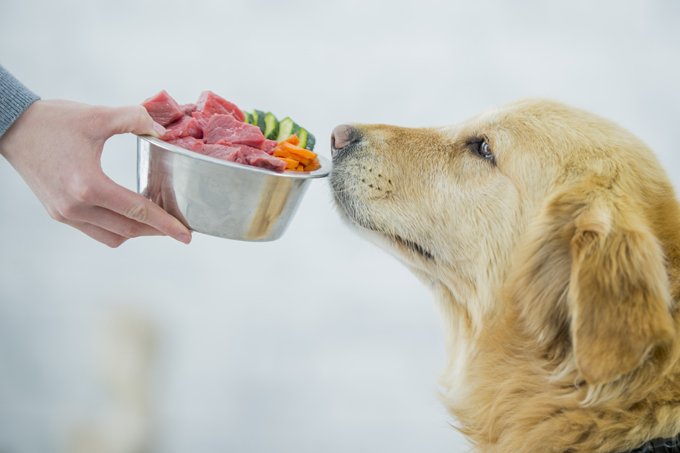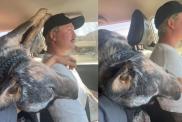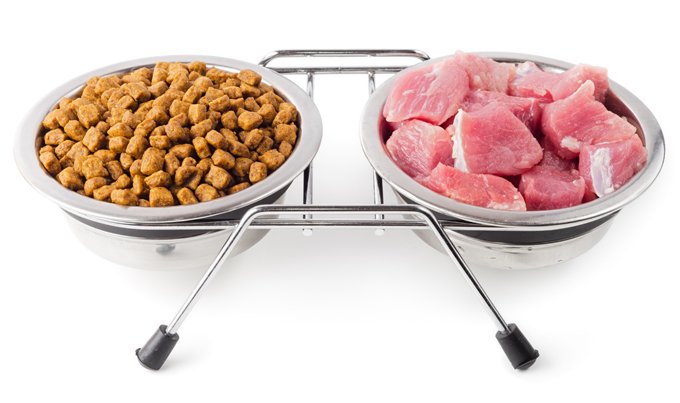
Did you know in this country alone, we spend close to $60 billion each year on pet health care and pet food? That number increases each year, actually…and yet, over the past decade, we’ve seen an 11% decrease in how long our dogs are living. Plus, our pets are presenting with more chronic health problems at younger and younger ages. But does it have to be this way? I don’t think so. In honor of Change a Pet’s Life Day, let me share with you one of the biggest ways you can impact your dog’s life for the better.
When we look at the top 10 reasons people take their dogs to the vet, they include things like skin allergies, ear infections, upset stomach/vomiting, diarrhea, arthritis, skin infections, bladder disease, and tumors. Almost all of these are related to what the dog is eating on a consistent basis. Can you believe that? Almost all the reasons people take their dogs to the vet—issues that nowadays occur so frequently we think of them as normal—could be prevented with a change in diet. We’re going to talk about that in a minute, but I want you to understand how important nutrition is to your dog’s health—and not just their health. Their longevity, their endurance, their mental acuity, their energy levels, their ability to live an optimal life—these are tied to the food.
Sometimes people who feed processed food—and by processed food, I mean kibble or canned food—tell me their dogs are healthy, so they don’t need to change what they’re feeding. Unfortunately, it doesn’t work like that. There’s something I think of as the rubber band effect that occurs in all dogs. I’m sure most of you have had an experience where you’re using a rubber band and it snaps on you. Maybe you’d used that rubber band a bunch of times, or maybe it was one you only used a few times. Maybe you stretched it really thin…but maybe not. Maybe it seemed stretched out when you used it, and you knew you were taking a chance it might snap, but perhaps it caught you by surprise when it broke because it had seemed fine. Whatever the case, there were some microscopic tears in the rubber band you couldn’t see, which weakened it until it couldn’t do what was being asked of it anymore. If you’re lucky, it’ll give you some sort of warning (an extra stretchy appearance, for example) it’s not as strong as it once was. But maybe it just snaps on you. Our dogs are the same way. When you feed them processed food, it starts to affect them, at first internally. When they’re young, their bodies don’t necessarily show the internal damage that’s occurring. But as they age, that damage starts to reveal itself in a bunch of ways. Maybe they have less energy. Maybe they start developing tumors. Maybe they start to get hot spots, or skin allergies, or really bad breath, or they have seizures, or pancreatitis, or arthritis. Maybe they aren’t as active as they were, or they can’t focus as well as they should. Whatever their sign is, it’s just like the stretched-out rubber band that will eventually snap.
But here’s the good thing—the opposite is also true. That means, if you support your dog through a proper diet, they can function at peak form. Their systems aren’t flooded with a bunch of things they can’t use and are bad for them, and so they remain healthy, full of energy, with sharp mental focus. They don’t present with the kinds of chronic diseases so many of our dogs these days have. They thrive. The difference between a raw-fed dog and a dog that’s fed processed food is absolutely amazing.
Processed-food diets are generally starch-based. Our dogs didn’t evolve to digest starches, and when they constantly eat carbohydrates, it causes inflammation (even the so-called “grain-free” foods don’t overcome this issue). Inflammation is the root cause of many chronic diseases, including arthritis and cancers, and we are causing inflammation in our dogs’ bodies by feeding them processed food.
Not only that, but even so-called high-quality kibble contains meat that’s often sub-par. Lots of pet food companies use rejected meat from the supermarket (the spoiled meat that didn’t get sold), and they also use what’s referred to in the industry as 4D meat, which means the animals they use for meat for the kibble were diseased, disabled, dying, or desiccated. It also means all the medicines given to those animals—all the antibiotics, hormones, steroids, and so on—are also in the kibble, because they don’t give those things a chance to pass out of the animals’ systems before they’re slaughtered.
Processed pet food also contains toxic preservatives like BHA, BHT, and Sodium Metabisulfites. These are used because pet food companies have to cover up the smell of spoiled meats and fats so you’ll still feed the food to your dog. And because processed pet food may sit on a shelf for a long time before it gets used, pet food manufacturers need to make sure it stays smelling nice and maintains the color we’ve come to expect, so pet owners will continue to feed it. The problem is these preservatives—and these are just a few of them—are linked to a whole host of problems, including allergies, behavior issues, decreased brain function, liver and stomach cancer, cell abnormalities, increases in the formation of fatty tumors, weakness, respiratory depression, diarrhea, nausea, vomiting. Remember our list of the top 10 reasons people take their dogs to the vet? Skin allergies, nausea, vomiting, diarrhea, tumors, and so on? There they are!
Finally, processed pet food is cooked. Our dogs, however, are carnivores that evolved to eat raw meat, bones, and organs. For dogs, the cooking process is unnecessary at best and toxic at worst. When kibble is cooked, it denatures the meat. In other words, it destroys the amino acid chains in the protein, which makes it very difficult for your dog to rebuild those amino acid chains into usable protein. Think of it this way. If you were trying to build a brick wall, and you had all your bricks neatly laid out and ready to go, and then someone came along and smashed all the bricks, you might be able to piece them back together and build some sort of haphazard wall, but it wouldn’t be very strong or stable. And if you had to build walls every day, and someone smashed the bricks every single day, none of the walls would be effective, and eventually you wouldn’t be able to do it anymore. Your dog is trying to build walls out of the protein in the food he eats, by using the amino acids to build proteins. But the cooking process smashes all the amino acids, which makes it very difficult to effectively build new proteins.
By now, you might be wondering how to switch your dog to a raw diet. There are a few ways to do it, but here I’m going to talk about how to switch to a DIY raw diet.
Making The Switch

To start, you can take one of two approaches. The first approach, and the one I usually favor, is to start the journey to raw feeding with a quick, decisive step. Wait 12-24 hours from the last feeding of kibble (this gives the system a chance to digest and pass out the processed food), then start feeding raw. If your dog doesn’t eat that meal, it’s OK to let them fast and try again at the next meal. It’s fine if they miss a few meals, and eventually healthy dogs will start eating the food you’re offering. And, the chances are good your dog may just dive right into the raw food, like they’ve been waiting for it all along!
The other option is to transition them slowly. If you go this route, feed them 75% of their daily kibble in the morning, then 25% of their total daily raw allotment in the evening. Do this for a few days, monitoring their stool to make sure it’s firm and regular. If everything is fine, move them to 50% of their daily kibble in the morning, then 50% of their total daily raw allotment in the evening. Again, monitor their stool to make sure everything is staying regular and firm. If so, you can move them to 25% kibble in the morning, 75% raw in the evening. Once their stool is firm and regular, you can move them to 100% raw and no kibble. The whole process could take up to a few weeks.
I haven’t had much problem with diarrhea or other digestive issues when transitioning using the first method, but some dogs do have trouble, so the latter method is probably safest if you’re concerned about your dog’s ability to handle the transition without digestive upset. Either option will get you there, so do whichever you feel most comfortable with. Just remember, if you use the first method, your dog may have some diarrhea or other issues. It’s important not to panic if that happens. You can slow the transition down, but make sure you keep transitioning.
What proteins should you start with?
Many people prefer to start their dog off on a raw diet of chicken, because it’s relatively inexpensive, easy to find, easy on the stomach, and full of soft digestible bones. It’s very bony, which helps firm up stool that may be softer due to the diet change and resulting detox. However, you don’t have to start with chicken—if you have access to a different protein source (beef, for example), start with that. Try to get organic or pasture-raised animals. Make sure they’re antibiotic- and hormone-free. And if you can’t find organic/pasture-raised, at least get a brand that isn’t enhanced (injected with saline and/or flavor enhancers).
Transitioning To New Proteins And Organs
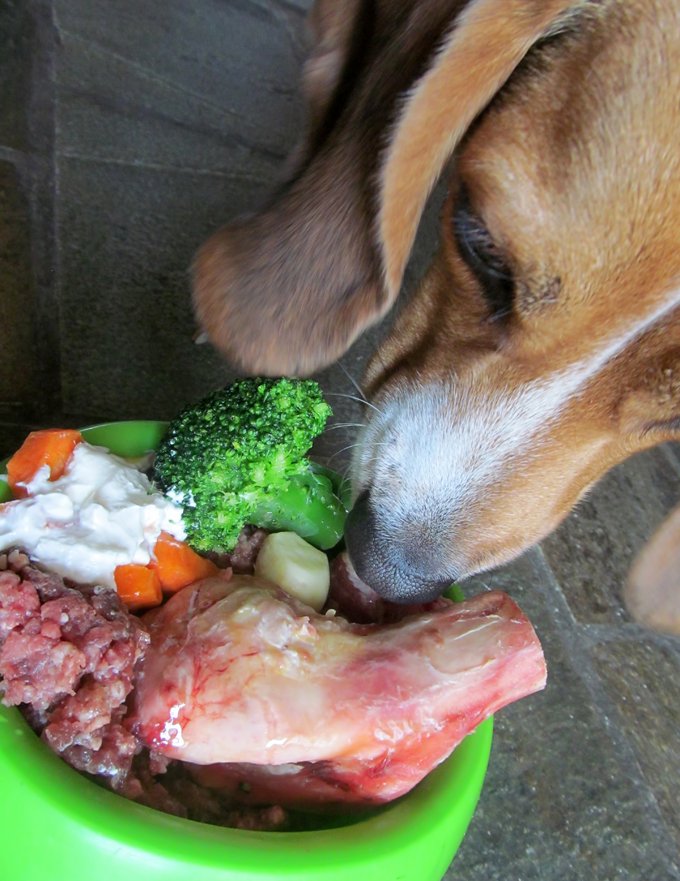
Whether you’re feeding commercial raw, prey model, or whole prey, try to feed the same protein source for at least a week, and preferably two, before you switch to a different protein source. Watch the stool to make sure it’s firm. You will notice your dog’s poop is much smaller, breaks down more quickly, and your dog doesn’t poop as much as they did when they were kibble-fed. Once the stool is consistently, but not overly, firm, start slowly introducing in organs (unless you’re feeding a commercial raw, which should already have organs in it). Start with liver and then start adding in other organ meats and glands. Basically, this includes all the parts that secrete and are squishy. You can feed all kinds of parts, such as liver, kidneys, blood eyes, testicles, lungs, brains, and so on. You can also start introducing other protein sources, but make sure to monitor your dog’s reaction to these changes. The key here is moderation, and there is no need to rush the introduction of new proteins or organs. Your dog will achieve a balanced diet over time, so whatever nutrients it doesn’t get in its meal today it will get tomorrow, or the day after that. This is the way animals in the wild also eat—with balance over time. If they required all their meals to be balanced in and of themselves every single time, they wouldn’t be able to function at an optimal level consistently. Our carnivore pets are the same way.
How Much Should You Feed Your Dog?
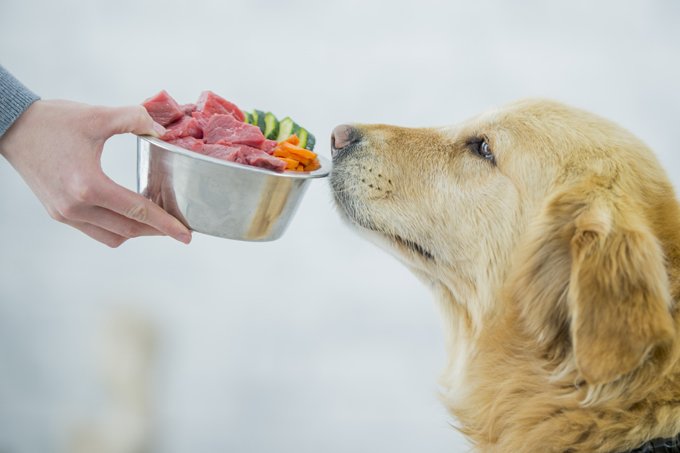
When figuring out how much to feed your dog, aim to feed about 2-3% of its ideal body weight per day. For puppies, aim to feed about 2-3% of their ideal adult body weight. If you have no idea what your puppy’s ideal adult body weight will be, you can aim for 10% of their current ideal body weight, but monitor their weight changes and adjust the amount given as they grow. If your dog is underweight or overweight, you can adjust the amount you’re feeding to help them achieve their optimal weight. Keep in mind many kibble-fed dogs are overweight, and as a society we’re used to seeing animals that are too heavy. When you look at your dog, you should be able to easily feel their ribs but not see them (unless their fur is very short). When you look down at your pet from above, you should see a narrowing where their hips are. If you can’t feel their ribs or see this narrowing, they’re too heavy. If their ribs or hip bones jut out sharply, they’re too thin. If their weight does need adjusting, do it slowly (balance over time!), and remember it’s better to have an animal that’s slightly thin than slightly heavy.
The 80/10/10 ratio
When you feed raw, you’re attempting to mimic what carnivores in the wild, particularly wolves, eat. The prey animals typically consumed by wolves and other predators in the wild are generally about 80-85% meat (including muscle meat, fat, connective tissue, skin, heart, lungs, and so on), 10-15% edible bone, and 5-10% organs. Therefore, general guidelines for a raw diet (both commercial raw and prey model) are about 80% meat, 10% bone, 5% liver, and 5% non-liver organs. If you feed a prey model diet, remember this is achieved over time, so if, for example, you feed a lot of meat with less bone for several days in a row, aim to feed a bit more bone at the next meal. Aim to achieve these percentages (the 80/10/10 ratio raw feeders often refer to) over the course of a week.
Doing the calculations
To calculate how much to feed your dog, figure out how much they weigh (or what their ideal weight is). Let’s assume you have a dog that weighs 40 pounds and you want to feed them 2% of their body weight per day. To get the total amount of meat, bone, and organs to feed, convert the percentage fed into a decimal: 2 ÷ 100 = 0.02. Then, to figure out the total weight in pounds your dog should eat per day (including treats!), multiply your dog’s weight (or ideal weight) by the decimal: 40 pounds x 0.02 = 0.8 lbs. You can then convert this to ounces to make it easier to figure out how much bone, meat, and organs to feed. To do this, multiply the pounds your dog should eat per day by 16: 0.8 x 16 = 12.8 ounces. Then use the 80/10/10 guideline to determine about how much meat, bone, and organ to feed.
- Meat/day: 12.8 ounces x 0.80 = 10.24 ounces/day
- Bone/day: 12.8 ounces x 0.10 = 1.28 ounces/day
- Liver/day: 12.8 ounces x 0.05 = 0.64 ounces/day
- Non-liver/day: 12.8 ounces x 0.05 = 0.64 ounces/day
When you make the switch to a species-appropriate diet, you will notice so many benefits, almost right away. I already mentioned their waste is much easier to deal with, but there are tons of other benefits too. That doggy odor goes away—which makes sense, when you think about it. They are predators, after all, so it doesn’t make sense they would have a strong odor to warn their prey they’re in the vicinity. Eating the raw bones will keep their teeth clean and white and their gums healthy, and it will help remove all that tartar and plaque buildup. You won’t have to get their teeth professionally cleaned, if you do, because they’ll be kept clean naturally. Because their poop gets a little harder, they have to strain a bit to pass it, which helps their anal glands work properly. Their coats are shinier and softer, they’re calmer, and another bonus is that, as many raw feeders will tell you, fleas and ticks aren’t nearly as attracted to them (we have zero issues with fleas and ticks anymore, and we don’t put any sort of Frontline or other flea/tick preventative on them).
Bottom line: If you’re looking to change your pet’s life for the better, this is perhaps the single greatest thing you can do for them.
-By Kristin Clark, MA, CSAN
Editor-in-Chief, Raw Pet Digest
Founder, Raw Pets Thrive Movement
www.rawpetsthrive.com
www.rawpetdigest.com
www.facebook.com/rawpetdigest
